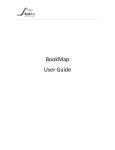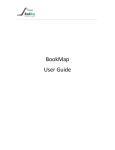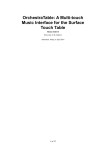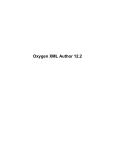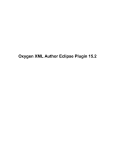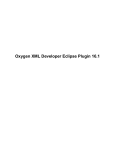Download BookMap User Guide
Transcript
______________________________________________________________________________ BookMap User Guide ______________________________________________________________________________ Introduction BookMap is an innovative analysis and trading application that delivers a consolidated visualization of past and present market depth using a configurable color scheme.BookMap keeps record of the order book activity over time and displays it to the trader together with current market depth. The visualization of the evolving order book activity provides the trader with an enhanced ability toanalyze market dynamics and patterns as well as assessing the perpetual strength and weakness of different price levels. BookMap allows the trader to quickly translate market analysis into trading actions with one click trading capability directly from the BookMap chart. 1. SystemRequirements The following hardware and software specifications are the minimal requirements for installing and using BookMap: a) b) c) d) e) f) Windows 7, Vista, 2000 or XP. Monitor with minimum resolution of 1024x768 Minimum of 3Gigabytes RAM and 40 Megabytes free disk space. Intel Core 2 DUO (or equivalent), 2.0 GHz or above+ Stable internet connection. Minimal speed 1Mb/sec A mouse with a middle button is required for one-click trading. 1. User manual BookMapis installed with live and replay (offline) modes. The live mode presents real-time market data transmitted from Interactive Brokers TWS. It also allows the transmission of orders to TWS through one-click order placement directly from the BookMapchart.The replay mode allows traders to replay recorded trading sessions and view the evolution of the order book over the entire session. Traders can place and execute simulated orders to verify how theirtrading decisions and strategies fit theiranalysis of the market based on BookMap insights. Unlike the live mode, BookMap Replay is independent of any trading platform and runs as a standalone application Page1of12 ______________________________________________________________________________ RunningBookMap Live a.) Before launching BookMap Live make sure your TWS platform is up and running and enable ActiveX and Socket Clients” is checked. TWS Configuration Window b.) Open BookMapLive. This will open the BookMapLive control window. Page2of12 ______________________________________________________________________________ c.) In the control windowclick Connect. This will open a connect window. Click OK on the connect window and then click yes on Interactive Brokers TWS request to accept incoming connection attempts. d.) After accepting incoming connection attempts, the Add Instrumentbutton on the BookMap Live control window will turn active. Click Add Instrumentto open the subscribe window and add the instruments of your choice. The number of instruments per session that can be added to BookMap is limited by TWS to three. Note that the details of the exchange and instrument of your choice must match those used by TWS so it can identify the request. Double clicking an instrument name in IB portfolio will open a description window detailing the exact syntax of the instrument and respective exchange. Page3of12 ______________________________________________________________________________ e.) After confirming the symbol details on the subscribe window, the symbol will be added to the BookMap live control window. Initially it will be displayed as a grayed out button but will turn active once new data is transmitted from TWS. Once active, click the symbol button to open the BookMapchart. BookMap Live General Orientation: Bookmap Live has several distinctive elements: a) The blue and green bars on the far right side represent the volume of executed orders at each price level accumulated from the start of the session. The blue and green colors represent the relative size of executed orders by each group of aggressors. Blue represents buyers were the aggressors and green represents sellers were the aggressors. This can help traders assess which aggressors had more power at the relevant price level since the start of the session. The volume bars can be reset to restart accumulating executed orders. This can be done either manually or automatically at a preset frequency. To reset the volume bars, place the mouse cursor over the volume bars area and right click to choose from either a manual reset or automatic reset settings. [See illustration in the next Page] Page4of12 ______________________________________________________________________________ b) The green and blue bars to the left of the volume bars represent the size of the current bid (blue) and ask (green) orders at each price level. c) The green and blue lines on the left side of the chart represent the best bid and ask prices. d) The color shadesof the various price levels represent the evolution of the order book during the session. BookMap keeps the history of the order book size at each price level with a matching color code. The brighter the color the larger the order book size at that price level. The color shade settings are configurable, as explained below. When a price level goes out of the range transmitted by the exchange (for example, CME transmits only the best 10 levels of bid and ask) BookMap keeps record of its last transmitted size and updates it once the level returns to the transmitted range. This allows traders to estimate market depth even beyond the exchange transmitted range. e) The progressing yellow vertical line represents the current time. The area left of the vertical line representshistorical price changes and order book size. The area to the right of the yellow line is an extended picture of the current price and the order book size. Page5of12 ______________________________________________________________________________ BookMap Chart Placing Orders: Every time the BookMapchartopens the one-click trading feature is disabled. To enable one click trading click the icon above the chart for trading configurations. This will open a new window. Check Enable One-Click Trading and specify the number of contracts per click (order size). Once One-Click Trading is enabled follow the instruction below to place or cancel orders: a) To place a Buy Limit order, click the left mouse button below the current bid at the desired price level. Note that clicking the left mouse button at or above the current ask will result in a buy at current market price. b) To place a Sell Limit order, click the right mouse button above the current ask at the desired price level. Note that clicking the right mouse button at or below the current bid will result in a sell at market price. Page6of12 ______________________________________________________________________________ c) A single mouse click places an order for the number of contracts specified by the trader in the trading configuration.Each additional mouse click will add another order for a similar number of contracts. d) To cancel pending orders, place the mouse pointer over the relevant price level and click the middle mouse button. e) To delete all of the pending orders at a certain price level place the mouse pointer over the relevant price level and press CTRL + click the middle mouse button. f) To cancel all pending orders click the g) To exit all open positions, click the icon above the chart. icon above the chart. Order Status: a) Cyan circle marks the placement of a buy order. The cyan line extends from the circle until the order is either filled or cancelled. A filed buy order is marked by cyan square. b) Magenta circle marks the placement of a sell order. The magenta line extends from the circle until the order is either filled or cancelled. A filed buy order is marked by magenta square. c) It is possible to define what type of order information will be displayed on the chart. By default pending orders, cancelled orders, and executions are all presented on the chart. To change the default settings click the the relevant information. icon for trading configurations and uncheck d) The pending orders and open positions are also designated by counters above the chart. e) P&L is indicated above the chart. The P&L is a summation of both the realized and unrealized P&L during the session. f) Orders generated for s specific instrument directly from TWS will also be displayed and updated on the BookMap chart opened for the same instrument. [See illustration in the next Page] Page7of12 ______________________________________________________________________________ BookMap Live with pending, cancelled and executed orders Approximation of Order Queue: BookMap can display an approximation of the position of the trader’s order in the queue of all pending orders at the relevant price level. Bookmarkapproximates the position in the queue according to a FIFO matching algorithm using a more pessimisticscenario relating to cancelled orders. The ability to display a more accurate position in the queue ultimately depends on the quality of data that is available for distribution on the trading platform. BookMap presents queue approximation with white vertical lines on top of the current order book histogram. The place in the queue is illustrated by the position of the line over the bar representing the current size of pending order at any given price level. In order to activate the presentation of the queue approximation, click the trading configurationand check Orders Queue. icon for Page8of12 ______________________________________________________________________________ Trades Visualization: BookMap can display a graphical representation of all trades (i.e. of all market participants) that took place during the session for the displayed instrument. BookMap draws varying sizes of red or yellow circles over the best bid and ask line. The circles are drawn with precision of a single pixel of your monitor. The area of the circle represents total executed volume. This size is scaled to create a reasonable range of circles per each instrument’s volume. The center of the circle represents the exact time and the volume weighted average price of all trades that occurred at given pixel (if occurred). According to the location of the circles on the price axis and the red-to-yellow color gradient used, users can identify whether the traded volume was initiated by buyer(s) or by seller(s).The redder the color of the circle, the greater the selling activity at that price and time. The yellower the color of the circles, the greater the buying activity at that price and time. To activate trades visualization, click the Market’s trades. icon for trading configuration and check Chart contrast and other Settings: a) BookMap automatically sets the contrast of the chart heat map based on the maximum size on the order book and the distribution of pending prders at the different price levels. Users can control when BookMap recalibrates the heat map contrast. It can be set at predefined frequencies and at every time the chart is recentered. To control these setting, click the contrast icon above the chart and check the recalibration options you want to use. User can also control the brightness of the display by using the slider on the contrast settings window. BookMap Contrast Configuration Page9of12 ______________________________________________________________________________ b) For a zoomed in and out view of the chart, clickthe and icons above the chart. c) Use the icon above the chart to scroll the chart sideways. Note that while the hand icon is pressed BookMap will keep the presentation anchored in the area chosen by the trader. While in scrolling mode the chart can be zoomed in and out while anchoring to the middle point of the current chart view. Zooming in and out in scrolling mode can be done either with the zoom in and out icons or with mouse scrolling. In order to switch back to current time, click the hand icon to release the dragging mode. [Intentionally left blank] Page10of12 ______________________________________________________________________________ BookMap Replay BookMap Replay enables to replay pre-recorded market data and place order in simulation mode during the replayed session. Except for playing non-real time data, the chart in the BookMap replay mode has the same features as in the live mode BookMap live Running BookMapReplay: a.) Open BookMap Replay. This will open BookMap Replay control window. f.) In the control window, click “Feed”. This will open a new window. Choose one of the text feed files and click “Open”. Each feed file represents a prerecorded trading sessions of up to 3 instruments. Page11of12 ______________________________________________________________________________ g.) The recorded instruments will now load. They will initially be displayed as grayed out buttons and will turn active once information is fully loaded. h.) You are now ready to replay the recorded session. Click any of the recorded instruments’button to open BookMap Replay chart window. Note that once the recorded instruments’data is loaded, their respective market data are replayedautomatically, even if the chart is not open. You can view the date and time progression on the top part of the BookMap replay control window. Click any of the active symbols’ buttons to open the relevant BookMap chart. i.) To pause and for faster or slower replay speed, use the controllers above the BookMap chart. Page12of12 ______________________________________________________________________________ BookMap User Guide














